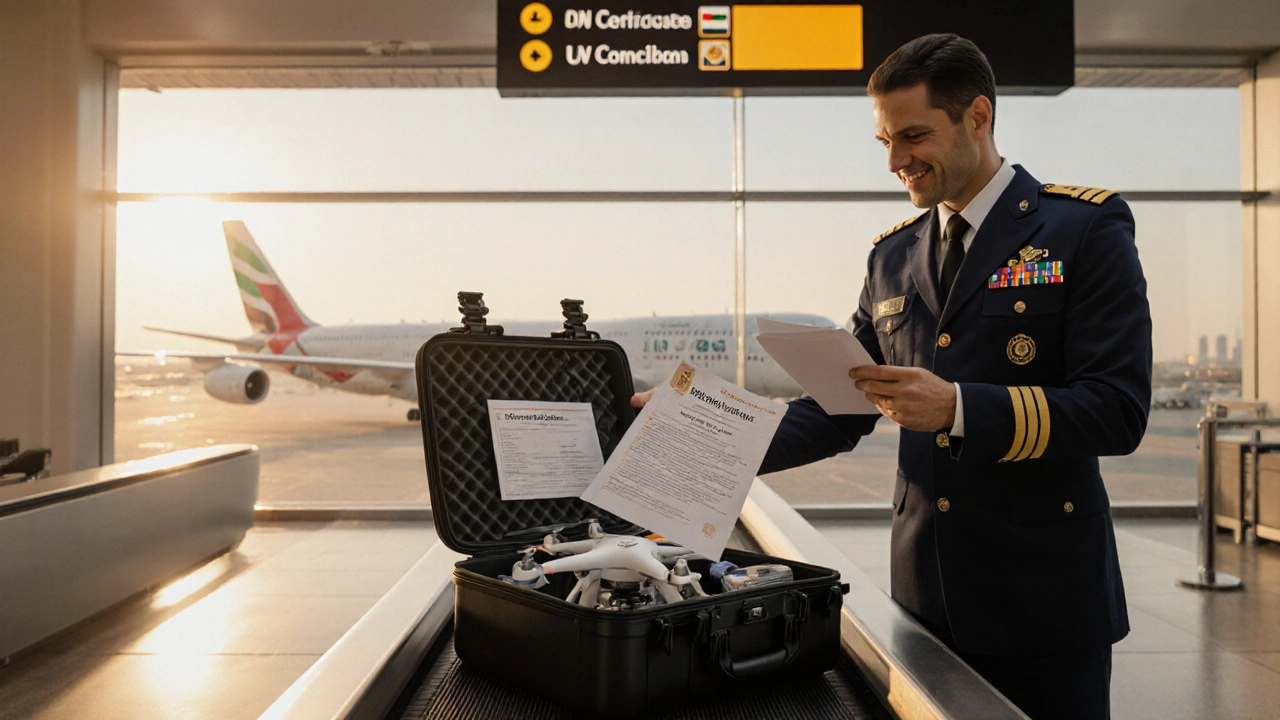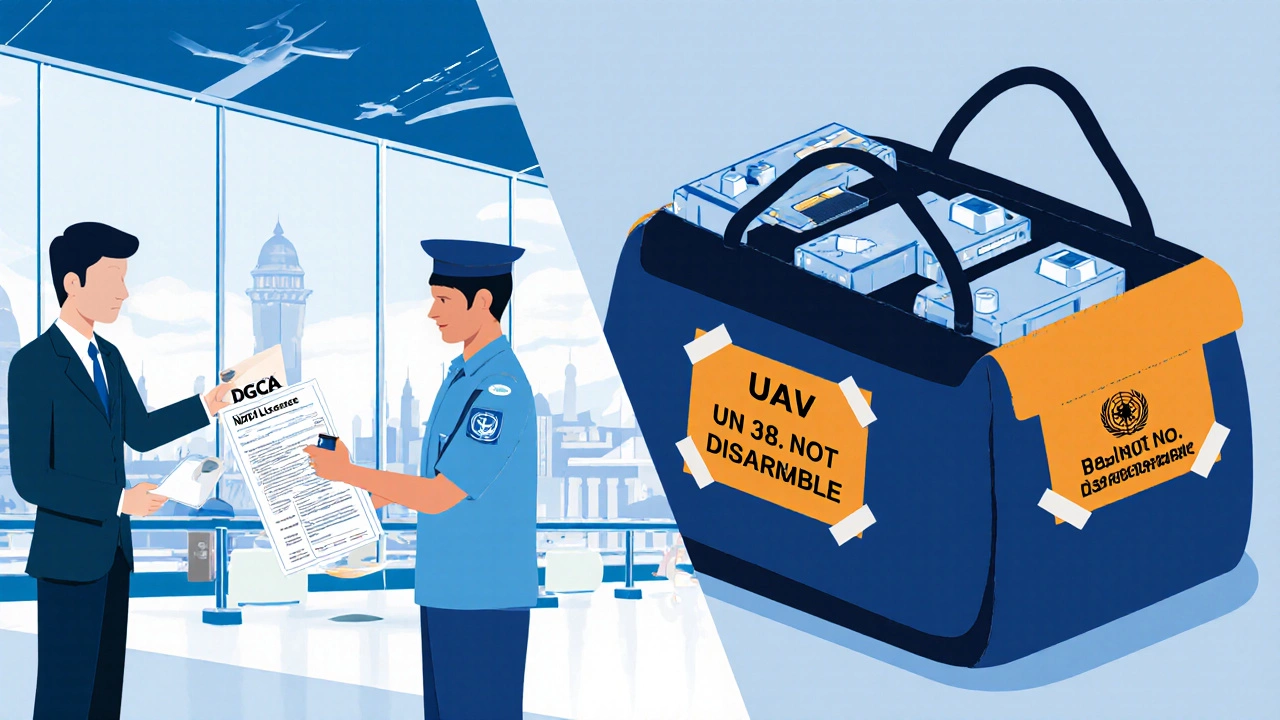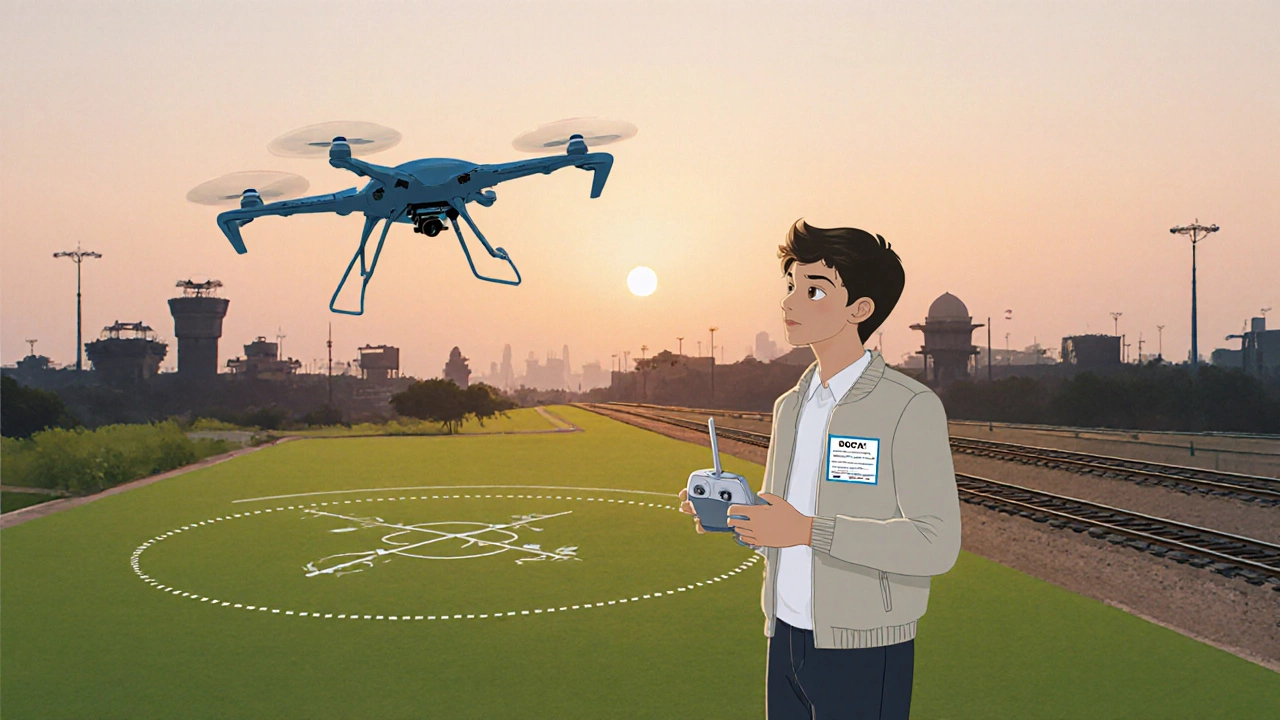How to Bring a Drone from Dubai to India - Rules, Permits & Checklist
 Oct, 10 2025
Oct, 10 2025
Drone Import Compliance Checker
Compliance Status
When you travel from Dubai to India, drone is a unmanned aerial vehicle (UAV) used for photography, mapping, or hobby flying. Bringing it across borders isn’t as simple as packing it in your bag - you need to follow both UAE export rules and Indian import regulations. This guide walks you through every step, from Dubai customs paperwork to the DGCA clearance you’ll need once you land in Delhi, Mumbai or any other Indian airport.
Key Takeaways
- India classifies drones under the Civil Aviation Requirements (CAR) and requires a permit for any import, even for personal use.
- Dubai allows export of drones but mandates a UAE export licence and a valid UN 38.3 battery certification.
- Both countries treat lithium‑ion batteries as hazardous goods - pack them in carry‑on, not checked luggage.
- For a hassle‑free entry, obtain a No‑Permission‑Required (NPR) certificate for hobby use or a Special Permission (SP) for commercial shoots.
- Keep a printed copy of your drone’s purchase invoice, registration number, and the DGCA permit handy for customs officers.
Understanding Indian Drone Regulations
India’s aviation authority, the Directorate General of Civil Aviation (DGCA), governs every UAV that touches Indian soil. Since the 2021 amendment to the Civil Aviation Requirements (CAR) - Part‑21, drones are split into two categories based on weight:
- Category A: ≤ 250g - allowed without a permit for recreational flight, provided you stay under 50m altitude.
- Category B: > 250g - requires either a No‑Permission‑Required (NPR) certificate (for personal use) or a Special Permission (SP) if you intend commercial work.
The key takeaway? Even a 300‑gram hobby drone from Dubai falls under CategoryB and must be cleared by the DGCA before you can fly it in India.
Dubai Export Checklist
Before you leave the UAE, make sure you’ve satisfied the following requirements. Missing any one of them can lead to a delay at Dubai International Airport (DXB) or a seizure of the UAV.
- Obtain an UAE Export Licence from Dubai Customs. The form asks for drone make, model, serial number, and purpose of travel.
- Secure a UN 38.3 Certificate for the lithium‑ion battery. This certifies that the battery passed safety tests for air transport.
- Print the original purchase invoice (showing a value underUSD1,500 to avoid high customs duty).
- Pack the drone in carry‑on luggage. Batteries must be removed from the device, placed in a protective case, and each cell should not exceed 100Wh.
- Declare the UAV on the Dubai Customs e‑form at check‑in. Use the code “UAV - unmanned aerial vehicle.”

What India Requires at Arrival
When you land in India, customs officers will ask for the same documents you prepared in Dubai, plus a few Indian‑specific forms.
- DGCA Permission: Submit an online application on the DGCA portal. Choose “NPR - Personal use” if you’re not earning money from the footage, or “SP - Commercial” for paid shoots.
- Proof of Ownership: Show the original invoice and the drone’s UAV Registration Number (if already registered in the UAE).
- Battery Certification: Carry the UN 38.3 certificate and a printed copy of the battery’s specification sheet.
- Import Duty: India levies a 10% Basic Customs Duty on drones valued aboveUSD1,000, plus a 12% GST on the total amount (duty + value). If the drone’s value is below the de‑minimis threshold (≈USD200), you may be exempt.
- Customs Declaration Form: Fill in the “Electronic Customs Declaration (e‑Form 11)” and mention the UAV’s weight, model, and intended use.
Step‑by‑Step Process to Bring Your Drone into India
- Plan Ahead (30‑45days before travel)
- Register your drone on the UAS‑UAV portal. Even if you’ll use the NPR route, registration creates a unique ID needed for the DGCA form.
- Apply for the UN 38.3 test through an accredited lab in Dubai. The result is usually delivered within a week.
- Obtain UAE Export Licence (7‑10days)
- Log in to Dubai Customs’ e‑services, upload the drone specs, invoice, and UN 38.3 PDF.
- Pay the modest export fee (≈AED150) and download the licence PDF.
- File DGCA Application (15‑20days)
- Choose the proper category (NPR or SP). For NPR, you’ll need a clear selfie with the drone, your passport copy, and the UAE export licence attached.
- Pay the online processing fee - INR2,000 for NPR, INR10,000 for SP.
- DGCA typically issues the certificate within 48hours for NPR, up to 5working days for SP.
- Pack the Drone Correctly
- Place the UAV in a hard‑shell carry‑on bag. Batteries go in a separate insulated pouch.
- Label the bag with “UAV - Do Not Disassemble” to avoid confusion.
- At Indian Customs
- Present the DGCA certificate, UAE export licence, UN 38.3 document, and invoice.
- If duty applies, pay in Indian Rupees at the counter. Keep the receipt - you’ll need it for any future resale.
- Flying Legally in India
- Stay within 5km of the airport you arrived at for the first 48hours - a safety rule for imported UAVs.
- Observe the “no‑fly zones” indicated on the Skymaps India portal. Military bases, railways, and certain city centres are off‑limits.
- Keep the DGCA certificate on you while operating - officers may ask for it during spot checks.
Battery & Carry‑On Rules - The Fine Print
Lithium‑ion cells are the biggest headache for travelers. Both the International Air Transport Association (IATA) and the Directorate General of Civil Aviation (DGCA) treat them as “dangerous goods.” Here’s how to stay compliant:
- Capacity limit: Each battery must not exceed 100Wh for carry‑on. If you have a 2‑cell 11.1V 3000mAh pack (≈33Wh), you’re safe.
- Quantity limit: Up to two spare batteries are allowed per passenger. Anything beyond that requires special cargo handling and a Dangerous Goods Declaration.
- Packaging: Keep terminals taped or placed in original manufacturer packaging. A simple zip‑lock bag isn’t enough.
- Declaring: When you fill the customs declaration form, tick the “Lithium‑ion batteries” box and attach the UN 38.3 PDF.

Common Pitfalls & How to Avoid Them
| Pitfall | Result | Prevention |
|---|---|---|
| Leaving the battery in checked luggage | Seizure or flight delay | Pack all batteries in carry‑on and label them. |
| Skipping the UN 38.3 test | Customs refusal at both ends | Book the test early; keep the certificate handy. |
| Using the drone without a DGCA certificate | Heavy fine (up toINR50,000) or confiscation | Apply for NPR or SP well before travel. |
| Flying over restricted zones | Legal action, possible drone impound | Check real‑time no‑fly maps before each flight. |
Quick Checklist Before You Fly
- UAE Export Licence - PDF printed.
- UN 38.3 Battery Certificate - original & digital copy.
- DGCA NPR or SP certificate - printed and saved on phone.
- Original purchase invoice (showing value
- Lithium‑ion batteries packaged per IATA rules.
- Customs duty receipt (if applicable).
- Pre‑flight plan with no‑fly zones checked.
Frequently Asked Questions
Do I need a DGCA permit for a sub‑250g drone?
No. CategoryA drones (≤250g) are exempt from both registration and permit, as long as you stay under 50m altitude and don’t fly in restricted zones.
Can I ship my drone as cargo instead of carrying it?
Yes, but you’ll need a Dangerous Goods Declaration for the batteries and a separate import licence from Indian customs. The process adds cost and time, so most travelers prefer carry‑on.
How long is an NPR certificate valid?
An NPR is valid for one year from the date of issuance, provided you don’t change the drone’s hardware or purpose.
What are the import duties for a $1,200 drone?
Basic Customs Duty = 10% of $1,200 = $120. GST = 12% of (value + duty) = 12% of $1,320 ≈ $158.40. Total ≈ $278.40, payable in INR at the current exchange rate.
Is there a penalty for flying without permission?
Yes. The DGCA can levy fines up toINR50,000, confiscate the UAV, and even initiate criminal proceedings if the flight endangers safety or breaches no‑fly zones.